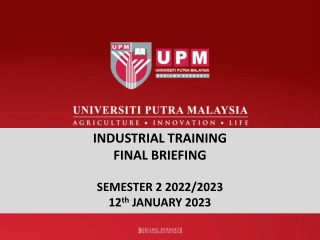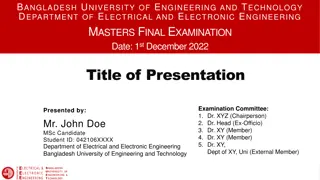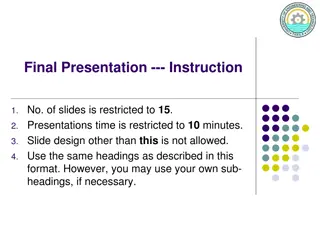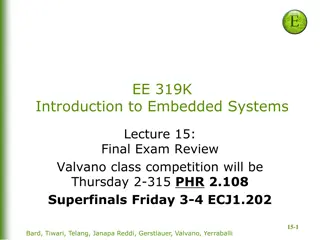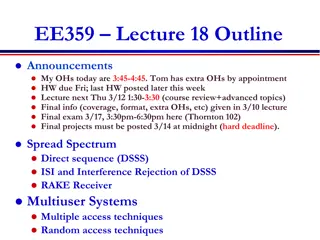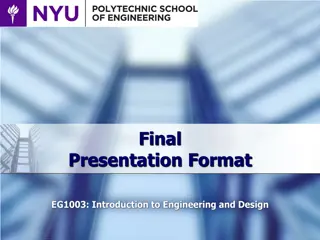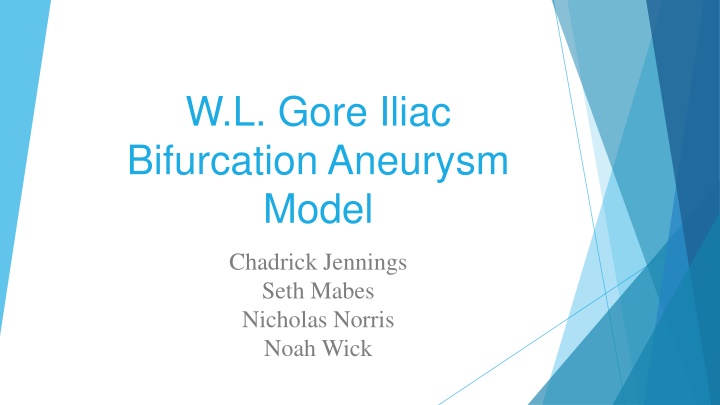
Innovative Model for Iliac Bifurcation Aneurysm Research
Explore a cutting-edge project aiming to create a realistic human iliac bifurcation model for peripheral endovascular device testing, led by a dedicated team of researchers. Discover the background, design, analyses, and advancements in medical device technology to ultimately save lives.
Download Presentation

Please find below an Image/Link to download the presentation.
The content on the website is provided AS IS for your information and personal use only. It may not be sold, licensed, or shared on other websites without obtaining consent from the author. If you encounter any issues during the download, it is possible that the publisher has removed the file from their server.
You are allowed to download the files provided on this website for personal or commercial use, subject to the condition that they are used lawfully. All files are the property of their respective owners.
The content on the website is provided AS IS for your information and personal use only. It may not be sold, licensed, or shared on other websites without obtaining consent from the author.
E N D
Presentation Transcript
W.L. Gore Iliac Bifurcation Aneurysm Model Chadrick Jennings Seth Mabes Nicholas Norris Noah Wick
Project Description Noah Wick
Background Aneurysm: Abnormal bulge on blood vessel caused by localized weak spot Aortic-Common Iliac Bifurcation: Location in which aortic artery bifurcates into two common iliac arteries Rate of occurrence: 2-4% in U.S. Adult Population Rate of Mortality: 50-70% if rupture occurs Risk Factors: Age 50+ Tobacco use Gender (male) Coronary artery disease
Project Description Problem Create a Realistic Model of the Human Iliac Bifurcation for Peripheral Endovascular Device Testing Sponsor WL Gore and Associates Faculty advisor Dr. Tim Becker Importance Advance medical device technology, Ethical considerations, Ultimately save lives
Design Description Seth Mabes
8 6 Design Description 5 7 3 9 2 1 4
8 6 Design Description 5 The tank holds the fluid Heater heats Fluid Pump moves fluid Tubing carries fluid to bifurcation Box holds bifurcation steady DAQ collects data from sensors GUI displays DAQ data Cart holds system and allows maneuverability 7 3 9 2 1 4
Analyses Summary The Team
CAD - Solidworks model Required - detailed understanding of the geometry that makes up the common iliacs.
Diameters, lengths, wall thicknesses The geometric values were averaged from numerous journal articles. These average values were organized and a model was created that matched them. This model was used for flow analysis.
Radii of Curvature and Angles of Take off These were also taken from averaged data. This was the most difficult thing to consider while modeling in solidworks. The bifurcation had to be castable, anatomically correct, and be able to be constructed in solidworks. This took numerous attempts.
Fluid Flow Analysis - Chadrick Jennings Assumptions Minor Losses Inviscid Incompressible Steady State Coupling between aorta and system K-value found online as basic coupling [1] Bifurcation K-value found online as y fitting [1] Aneurysm Entrance to aneurysm k-value was an average between: Sudden Expansion [2] Diffuser [3] Exit from aneurysm k-value was an average between: Sudden Contraction [2] Nozzle [2] Major Losses Entry lengths for FDF Pump to Coupling Coupling to Bifurcation Friction Factor based on Laminar Flow
Fluid Flow Analysis (cont.) Results Total Head Loss: Major and Minor added together Shear Stress Distribution: Average diameter used for calculation Rough estimate for the system h = 0.0014 m^2/s^2 ?_rx = -0.019 Pa Pressure Drop: Known inlet pressure from analytical data Calculated pressure drop over entire system P = 2.77 Pa
Manufacturing Analysis - Seth Mabes Goal Compare different manufacturing possibilities Time, Materials, ease and Overall cost Succinct manufacturing process Cut lost time and materials Model Volumes Inner /outer Mold Volumes
Lost wax method Materials Price Amount Quantity Use quantity to create molds quantity per casting (post silicone) quantity for 13 casts acrylic 12x24x3/16 Sulfer-free clay universal mold release 3D print 32 oz mixing containers two part silicone paraffin wax polyurethane 24.9954 in^3 13.915 lbs 16.4514 Fl oz 31 print 39.96100 cups 115gallon 4.99555 ml 115gallon total cost of materials 1casting box 1create split zone 3spray onto molds 2core for molds 1mixing materials 1create 2 molds 1inner core 1cast material 1sheet 2lb 3Fl oz 2prints 6cups 0.5gallons 0 0 0 0 3Fl oz 0 3cups 1use per mold 35ml (reusable) 14ml 0 0 39Fl oz 0 39cups 0 325ml 0.2gallons 355.29USD Quantity Silicone Per mold Acrylic 2861 ml 22 130.36mm x 55mm (long side) 2 109mm x 55mm (short side) 1 132mm x 109mm (base) Part A 376 ml Part B 38 ml
Materials - Noah Wick Determining Arterial Wall Elasticity/Compliance [4] Arteries are Heterogeneous Materials: 3 Concentric layers Tunica Adventitia: Outer Layer Tunica Media: Middle Layer Tunica Intima: Inner Layer Medical device interface Arteries Exhibit Complex Viscoelastic behavior Time, Pressure, Volume Dependent Hardness [5] Measured With Shore Durometer Device Sealing
Arterial Wall Properties Hardness [5] No Mathematical Calculations Measured with Shore durometer 41 Shore 00 ~ 5 Shore A Elasticity, Compliance, Viscoelastic Response [6] Intima layer Standard linear solid model Maxwell Representation
Mechanical Properties of Casting Materials Hardness 15 - 40 Shore A Softening Agent May Increase Viscous Behavior? Elasticity, Compliance, Viscoelastic response Hybrid Rheometer Testing Complex Modulus Storage Modulus Loss Modulus Viscosity Manufacturing
Design Requirements Chadrick Jennings
Design Requirements Safe per ANSI/OSHA (10) Match Aneurysm Geometry (9) Easy to Move (3) Allow Visualization of Device Deployment (9) Stable Base (4) Replicable Manufacturing Process (9) Mimic Anatomical Flow Conditions (8) Display Pressure (5) Match Aneurysm Mechanical Properties (7) Display Flow Rate (5)
Design Requirements How They ve Changed: Removed Display aneurysm volume Increased ranking of Repeatable manufacturing process to 9
Design Requirements Does the Design stack up? Aneurysm model with anatomical geometry Materials selected to closely mimic mechanical properties Clear materials to see device deployed Pump with appropriate pressure head to get accurate anatomical flow Sensors to measure pressure and flow rate GUI to display data
Schedule & Budget Nicholas Norris
References [1] loss-from-fittings-excess-head-k-method/. [Accessed: 06- April- 2019] Neutrium.net, Pressure Loss from Fittings - Excess Head (K) Method , 2012. [Online]. Available: https://neutrium.net/fluid_flow/pressure- [2] P. J. Pritchard, J. W. Mitchell, Fox and McDonald s Introduction to Fluid Mechanics, 9th Ed. United States of America: Wiley, 2015. E. F. Brater, H. W. King, Handbook of Hydraulics , 7th Ed. Boston: McGraw Hill, 1996. [3] [4] C. Maclean, "Shore OO Hardness Measurement of Bovine Aorta and Mock Vessel Materials for Endovascular Device Design". [5] G. E. M. et. al., "Arterial Compliance," in Cardiovascular Medicine, London, Springer, 2007, pp. 1811-1825. [6] A. Lundkvist et al, "Viscoelastic Properties of Healthy Human Artery," in Materials Research Society Conference Proceedings, San Francisco, CA, 1998.

